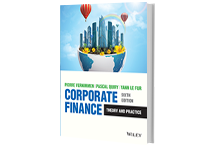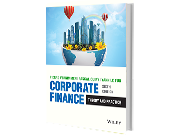Comment, question or quotation of the day
27-10-2025 : When the Administrative Court of Appeal gives finance lessons to the tax authorities, episode 2
In the previous post, we saw how the Paris Administrative Court of Appeal corrected the tax authorities, who claimed that, in order to calculate a company's cost of capital, they used a risk-free rate calculated over two years and a historical risk premium calculated over 25 years.
1. To justify its use of a historical premium, the tax authorities argued that it was relevant because Imperial Brands Seita was a long-term shareholder; whereas if it had been a short-term shareholder, a prospective premium would have been relevant.
The rapporteur was not swayed by this specious and sui generis argument put forward by the tax authorities, which contradicted the tax authorities' valuation guide: "In any event, there is no such thing as a sui generis tax value or administrative valuation methods: market value can only be determined by observing the market and using the methods employed by its participants."
The rapporteur emphasised: "If I buy LVMH shares to contribute to a PEA (personal equity plan) to finance my retirement in 20 years' time, or if I buy them to speculate on the stock market in the hope of paying for a trip to Namibia in the short term, the price of the shares will be exactly the same." This is common sense.
And to further disqualify the historical risk premium, the rapporteur repeats one of Vernimmen's arguments. When markets fall because investors demand higher rates of return, the historical risk premium, which is the average of annual market returns in excess of the risk-free rate, falls as a result, even though the rates of return demanded by investors are rising, which is paradoxical.
2. On another point, the tax authorities had considered that all cash assets should be taken into account in the transition from entreprise value to equity value. SEITA contested this, since part of these cash assets is the result of excise duties (SEITA manufactures cigarettes) which it must pay to... the tax authorities.
The rapporteur ruled in SEITA's favour, as the cash counterpart of negative working capital is not automatically a permanent asset of the company and therefore part of its value (see October's Vernimmen newsletter). One can imagine how the tax authorities would have reacted if SEITA had told them that it was unable to pay them the excise duties collected, having used them, for example, to pay a dividend to its shareholder!
3. As SEITA had probably paid the amount of the adjustment, the State will reimburse it the sum plus interest, which will further increase the budget deficit. There are cases where the tax authorities should seek the advice of valuation experts before embarking on procedures whose foundations prove to be uncertain.
26-10-2025 : When the Administrative Court of Appeal gives finance lessons to the tax authorities, episode 1
1. To justify a tax adjustment of approximately €300 million for SEITA, the tabacco group subsidiary of Imerial Brands, the tax authorities had calculated the cost of capital using :
a two-year average of risk-free interest rates
and a historical risk premium calculated on the basis of the 1987-2012 average.
In the first instance, the court ruled in their favour.
However, on appeal, SEITA won the case.
The Paris Administrative Court of Appeal, which had read its Vernimmen, pointed out that consistency was required in the CAPM formula used to estimate a company's cost of equity, or its cost of capital.
The formula states that the required rate of return is equal to: rf + ß x (E(rm) – rf). A risk premium (E(rm) – rf) is thus added to the risk-free rate (rf), weighted by the beta of the share to determine the cost of equity, or by the beta of operating assets (unleveraged beta) to obtain the cost of capital in the direct approach. It goes without saying that the rf at the beginning of the formula is the same as the rf at the end of the formula in the equity market risk premium!
However, there is every chance that two different values will be used for the same rf in the formula, if we take:
the risk-free rate of return to be an average interest rate over two years,
and the risk premium used is calculated as an average of the stock market risk premiums over 25 years.
This is unfortunate, but in this particular case it allowed the tax authorities to apply a lower discount rate than that used by SEITA, resulting in a higher entreprise value than that used by SEITA, hence the adjustment notified.
2. This is precisely why, for years, almost all valuers have been using forward-looking risk premiums rather than historical risk premiums calculated over varying periods of time. The forward-looking risk premium corresponds to the premium observed on the basis of current prices and the future cash flow prospects of the assets.
3. Although the risk premium is very often mentioned, the expected market return (E(rm) in the formula) is in fact a more operational criterion for valuation. It allows the risk premium to be calculated using:
either a short-term risk-free rate, as we recommend,
or a long-term rate (10-year OAT), as has been the customary but erroneous practice. Indeed, fluctuations in the price of a long-term OAT clearly show that it is not risk-free, which is unfortunate for a risk-free rate! And yet this is what is required to arrive at the CAPM formula (the standard deviation of risk-free asset returns must be zero).
This frees us from the choice made in this area by the person who calculated and published the risk premium, and avoids the error that the court criticised the tax authorities for.


Glossary
The Vernimmen.com glossary provides definitions for a couple of thousands of financial, stock market or economic terms.
This financial dictionary allows beginners to progress in their learning of finance and to experts to cease the precise meaning of a sentence.

Quiz
The Vernimmen.com Quiz offers over 300 questions with answers to progress in your understanding of finance and to test your knowledge.
Questions are sorted by key topics (financial analysis, investment and stock markets, value, financial engineering and financial management).

Survey
We frequently ask our readers to give us their point of view on a specific topic.
You will find here the current survey with the to-date status of answers as well as past polls.

Financial data
Thanks to our partner Infinancial, we can offer on this page financial data on over 16 000 groups around the world.
Updated several times a year, this database offers information sometimes hard to find elsewhere (beta, …)
The Vernimmen.com Letter
Number 167 of October 2025
News : Should layoffs for economic reasons be prohibited if dividends have been paid or profits made?
Statistics : The Forex market
Research : Investments by large companies: between the search for liquidity and tax optimisation
Q&A : How should the minimum cash reserves required by a regulator be treated in valuation works
COMMENTS : Comments posted on Facebook



